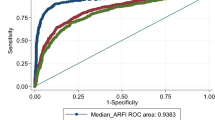Abstract
Purpose
To investigate the frequency of discordance and to identify factors associated with discordance between ultrasonographic and elastographic grades for assessing hepatic fibrosis in Asian patients with chronic hepatitis B.
Methods
Three hundred thirty-four patients with chronic hepatitis B for which both conventional ultrasonography and liver stiffness measurements using elastography were available were included. Patients were graded as ‘normal’, ‘chronic liver disease’, or ‘liver cirrhosis’ by ultrasonography, and as ‘no significant fibrosis’, ‘significant fibrosis’, or ‘liver cirrhosis’ by elastography, and the results of these two modalities were compared. Logistic regression analyses were performed to identify independent factors associated with discordant results.
Results
Of the 334 patients, 153 (45.8 %), 115 (34.4 %), and 66 (19.8 %) patients were ‘normal’, ‘chronic liver disease’, and ‘liver cirrhosis’, respectively, based on the ultrasonographic grades, and 290 (86.8 %), 29 (8.7 %), and 15 (4.5 %) patients were ‘no significant fibrosis,’ ‘significant fibrosis’, and ‘liver cirrhosis’, respectively, based on the elastographic values. Among them, 173 (51.8 %) showed discordance with respect to severity of hepatic fibrosis. In multivariable analysis, discordance was more frequent in patients with ultrasonographic grades of ‘chronic liver disease’ [adjusted odds ratio (AOR), 1924; P < 0.001] and ‘liver cirrhosis’ (AOR, 4498; P < 0.001), whereas patients with an elastographic grade of ‘liver cirrhosis’ showed a negative association with discordance (AOR, 0.002; P = 0.007).
Conclusion
There was a high rate of discordance between hepatic fibrosis grades determined by ultrasonography and elastography. Considering the accuracy of liver stiffness evaluation by elastography, conventional ultrasonography might overestimate hepatic fibrosis in chronic hepatitis B.



Similar content being viewed by others
References
Friedman SL. Seminars in medicine of the Beth Israel Hospital, Boston. The cellular basis of hepatic fibrosis. Mechanisms and treatment strategies. N Engl J Med. 1993;328:1828–35.
Piccinino F, Sagnelli E, Pasquale G, et al. Complications following percutaneous liver biopsy. A multicentre retrospective study on 68,276 biopsies. J Hepatol. 1986;2:165–73.
Regev A, Berho M, Jeffers LJ, et al. Sampling error and intraobserver variation in liver biopsy in patients with chronic HCV infection. Am J Gastroenterol. 2002;97:2614–8.
Bolondi L, Gandolfi L, Arienti V, et al. Ultrasonography in the diagnosis of portal hypertension: diminished response of portal vessels to respiration. Radiology. 1982;142:167–72.
Okuda K. Early recognition of hepatocellular carcinoma. Hepatology. 1986;6:729–38.
Leung VY, Shen J, Wong VW, et al. Quantitative elastography of liver fibrosis and spleen stiffness in chronic hepatitis B carriers: comparison of shear-wave elastography and transient elastography with liver biopsy correlation. Radiology. 2013;269:910–8.
Wang J, Guo L, Shi X, et al. Real-time elastography with a novel quantitative technology for assessment of liver fibrosis in chronic hepatitis B. Eur J Radiol. 2012;81:e31–6.
Sporea I, Sirli R, Bota S, et al. Comparative study concerning the value of acoustic radiation force impulse elastography (ARFI) in comparison with transient elastography (TE) for the assessment of liver fibrosis in patients with chronic hepatitis B and C. Ultrasound Med Biol. 2012;38:1310–6.
Sporea I, Bota S, Peck-Radosavljevic M, et al. Acoustic radiation force impulse elastography for fibrosis evaluation in patients with chronic hepatitis C: an international multicenter study. Eur J Radiol. 2012;81:4112–8.
Ferraioli G, Tinelli C, Lissandrin R, et al. Point shear wave elastography method for assessing liver stiffness. World J Gastroenterol. 2014;20:4787–96.
Ma JJ, Ding H, Mao F, et al. Assessment of liver fibrosis with elastography point quantification technique in chronic hepatitis B virus patients: a comparison with liver pathological results. J Gastroenterol Hepatol. 2014;29:814–9.
Korean Association for the Study of the L. KASL clinical practice guidelines: management of nonalcoholic fatty liver disease. Clin Mol Hepatol. 2013;19:325–48.
Carol A, Mittelstaedt LMV. Abdominal ultrasound. New York: Churchill Livingstone; 1987. p. 1–80.
Colli A, Fraquelli M, Andreoletti M, et al. Severe liver fibrosis or cirrhosis: accuracy of US for detection–analysis of 300 cases. Radiology. 2003;227:89–94.
Rumack CM, Wilson SR, Charboneau JW. Diagnostic ultrasound. 2nd ed. St. Louis: Mosby; 1998. p. 110–2.
Aube C, Oberti F, Korali N, et al. Ultrasonographic diagnosis of hepatic fibrosis or cirrhosis. J Hepatol. 1999;30:472–8.
D’Onofrio M, Martone E, Brunelli S, et al. Accuracy of ultrasound in the detection of liver fibrosis in chronic viral hepatitis. Radiol Med. 2005;110:341–8.
Needleman L, Kurtz AB, Rifkin MD, et al. Sonography of diffuse benign liver disease: accuracy of pattern recognition and grading. AJR Am J Roentgenol. 1986;146:1011–5.
Gosink BB, Lemon SK, Scheible W, et al. Accuracy of ultrasonography in diagnosis of hepatocellular disease. AJR Am J Roentgenol. 1979;133:19–23.
Debongnie JC, Pauls C, Fieves M, et al. Prospective evaluation of the diagnostic accuracy of liver ultrasonography. Gut. 1981;22:130–5.
Zoli M, Cordiani MR, Marchesini G, et al. Ultrasonographic follow-up of liver cirrhosis. J Clin Ultrasound. 1990;18:91–6.
Summary of safety and effectiveness. iU22 diagnostic ultrasound system. (updated 2015 June; created 2013 June). http://www.accessdata.fda.gov/cdrh_docs/pdf13/K130499.pdf.
Wang JH, Changchien CS, Hung CH, et al. Liver stiffness decrease after effective antiviral therapy in patients with chronic hepatitis C: longitudinal study using fibroscan. J Gastroenterol Hepatol. 2010;25:964–9.
Yo IK, Kwon OS, Park JW, et al. The factors associated with longitudinal changes in liver stiffness in patients with chronic hepatitis B. Clin Mol Hepatol. 2015;21:32–40.
Gaiani S, Gramantieri L, Venturoli N, et al. What is the criterion for differentiating chronic hepatitis from compensated cirrhosis? A prospective study comparing ultrasonography and percutaneous liver biopsy. J Hepatol. 1997;27:979–85.
Acknowledgments
We thank Miyeon Lee for assisting with the statistical analysis for this study.
Author information
Authors and Affiliations
Corresponding author
Ethics declarations
Conflict of interest
There are no financial or other relations that could lead to a conflict of interest.
Ethical considerations
All procedures followed were in accordance with the ethical standards of the responsible committee on human experimentation (institutional and national) and with the Helsinki Declaration of 1975, as revised in 2008. Informed consent was waived.
About this article
Cite this article
Kim, M.S., Kim, B.I., Kwon, HJ. et al. Discordance between conventional ultrasonography and ElastPQ for assessing hepatic fibrosis in chronic hepatitis B: frequency and independent factors. J Med Ultrasonics 43, 201–210 (2016). https://doi.org/10.1007/s10396-015-0684-7
Received:
Accepted:
Published:
Issue Date:
DOI: https://doi.org/10.1007/s10396-015-0684-7




